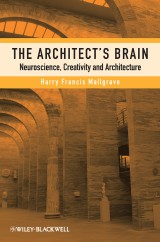Details

The Architect's Brain
Neuroscience, Creativity, and Architecture1. Aufl.
|
30,99 € |
|
| Verlag: | Wiley-Blackwell |
| Format: | EPUB |
| Veröffentl.: | 25.05.2011 |
| ISBN/EAN: | 9781118078679 |
| Sprache: | englisch |
| Anzahl Seiten: | 288 |
DRM-geschütztes eBook, Sie benötigen z.B. Adobe Digital Editions und eine Adobe ID zum Lesen.
Beschreibungen
<p><b><i>The Architect's Brain: Neuroscience, Creativity, and Architecture</i> is the first book to consider the relationship between the neurosciences and architecture, offering a compelling and provocative study in the field of architectural theory.</b></p> <ul> <li>Explores various moments of architectural thought over the last 500 years as a cognitive manifestation of philosophical, psychological, and physiological theory</li> <li>Looks at architectural thought through the lens of the remarkable insights of contemporary neuroscience, particularly as they have advanced within the last decade</li> <li>Demonstrates the neurological justification for some very timeless architectural ideas, from the multisensory nature of the architectural experience to the essential relationship of ambiguity and metaphor to creative thinking</li> </ul>
<p>Introduction</p> <p>Part One: Historical Essays</p> <p>1. The Humanist Brain (Alberti, Vitruvius, and Leonardo).</p> <p>2. The Enlightened Brain (Perrault, Laugier, and Le Roy).</p> <p>3. The Sensational Brain (Burke, Price, and Knight).</p> <p>4. The Transcendental Brain (Kant and Schopenhauer).</p> <p>5. The Animate Brain (Schinkel, Bötticher, and Semper).</p> <p>6. The Empathetic Brain (Vischer, Wölfflin, and Göller).</p> <p>7. The Gestalt Brain (The Dynamics of the Sensory Field).</p> <p>8. The Neurological Brain (Hayek, Hebb, and Neutra).</p> <p>9. The Phenomenal Brain (Merleau-Ponty, Rasmussen, and Pallasmaa).</p> <p>Part Two: Neuroscience and Architecture.</p> <p>10. Anatomy: Architecture of the Brain.</p> <p>11. Ambiguity: Architecture of Vision.</p> <p>12. Metaphor: Architecture of Embodiment.</p> <p>13. Hapticity: Architecture of the Senses.</p> <p>14. Epilogue: The Architect's Brain.</p> <p>Endnotes.</p> <p>Bibliography.</p> <p>Index.</p>
"Hence these two books from the same publisher and by the same author, Harry Francis Mallgrave, sole writer of the former and co-author with David Goodman of the second book, make a valuable contribution to this growing field of knowledge." (Architectural Review, 1 July 2011)<br />
<b>Harry Francis Mallgrave</b> is a professor of architecture at Illinois Institute of Technology, and has enjoyed a distinguished career as an award-winning scholar, translator, and architect. His most recent publications include <i>Modern Architectural Theory: A Historical Survey, 1673-1968</i>, and the two-volume <i>Architectural Theory: An Anthology from Vitruvius to 2005</i> (Wiley-Blackwell 2008). His forthcoming <i>Introduction to Architectual Theory</i> will be published by Wiley-Blackwell in 2010.
Did classical and Renaissance theory in fact have a biological basis? Does the architect possess a highly specialized brain? Is neuroscience today providing architecture with a new foundation for design thought?<br /> <br /> <p>These are a few of the compelling suggestions offered by this richly detailed study, which explores--from two perspectives--the issue of how architects and designers view the phenomenal world. In part one of <i>The Architect's Brain</i>, Mallgrave sketches various moments of architectural thought over the last 500 years as a cognitive manifestation of philosophical, psychological, and physiological theory. In part two, he repositions this question from the perspective of the remarkable insights of contemporary neuroscience, particularly as they have advanced within the last decade.</p> <p>What emerges is a surprising neurological justification for some very timeless architectural ideas, from the multisensory nature of the architectural experience to the essential relationship of ambiguity and metaphor to creative thinking. The author cogently argues that architecture (aside from its intellectual affectations) is radically an emotional and perceptual act grounded in biological values that should be placed in the foreground. Not since Richard Neutra's <i>Survival Through Design</i> (1954) has such a provocative thesis been put forth in the field of architectural theory.</p>
"A gripping interpretation of how the latest advances in neuroscience enlarge our understanding of architecture from Alberti’s belief that a building is a ‘form of body’ to the computer whose dominance in architecture Mallgrave challenges." David Watkin, University of Cambridge

















